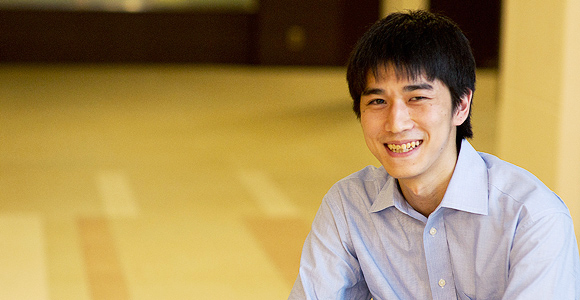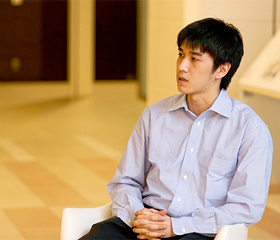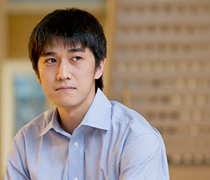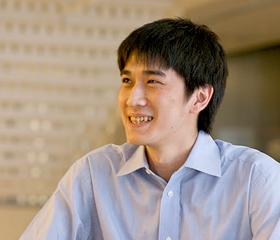Kenichiro Ito

SDM trains the next generation of leaders,
who will be neither generalists nor specialists
Kenichiro Ito
(entered spring, 2011)
Graduated from the Faculty of Business and Commerce, Keio University in March 2010
Current focus and research
Motorcycles, human interfaces, augmented reality
Investing in yourself
 I think there are two types of students who come to SDM. The first are those who finish their education, go out into the world and then realize the importance of further education; the second are those who come directly after earning their undergraduate degree. The first group consists mostly of people sent by their companies and people who have decided to open new doors for themselves. The second group has an issue that they want to work on, a problem in society that they want to solve before they leave the university. I think that education is the best investment you can make in yourself; the first group of students is investing "operating capital," the second, "startup costs." It is not a question of which one is better. The key point is that when you invest in education, at whatever juncture in your life, there will always be a payoff. At SDM, the ALPS projects provide an opportunity to work with companies, practicing concepts that have been learned, obtain a payoff, and setting one's sights even higher. You can drive educational innovation by raising standards. This is a place where you learn about the forefront of today's society while gaining expert, professional knowledge, and when you emerge you have both a theoretical and a practical understanding of the entire process of incorporating these insights into products and social systems.
I think there are two types of students who come to SDM. The first are those who finish their education, go out into the world and then realize the importance of further education; the second are those who come directly after earning their undergraduate degree. The first group consists mostly of people sent by their companies and people who have decided to open new doors for themselves. The second group has an issue that they want to work on, a problem in society that they want to solve before they leave the university. I think that education is the best investment you can make in yourself; the first group of students is investing "operating capital," the second, "startup costs." It is not a question of which one is better. The key point is that when you invest in education, at whatever juncture in your life, there will always be a payoff. At SDM, the ALPS projects provide an opportunity to work with companies, practicing concepts that have been learned, obtain a payoff, and setting one's sights even higher. You can drive educational innovation by raising standards. This is a place where you learn about the forefront of today's society while gaining expert, professional knowledge, and when you emerge you have both a theoretical and a practical understanding of the entire process of incorporating these insights into products and social systems.
Management
 At an ordinary educational institution, the instructors lay out your course of studies for you. SDM only provides broad guidelines; there is no one set path that you must take. It is easy enough to climb a well-marked path, but much more difficult to create your own path as you move forward. One that distinguishes SDM is the ability to set your own starting points and destinations. You'll probably have to reset them many times along the way, because our first paths are usually hazy and ill-defined. Along the way, advisers and professors provide guidance to bring some clarity. Sometimes, this feeds back to other SDM students and faculty members, impacting the entire school. There is a virtuous cycle in which your individual creativity and commitment have an impact on the whole, and those results are fed back to further impact you. It is indeed the embodiment of the Keio University principle of "half-student/half-teacher" in a system. System design is only possible when you rid yourself of fixed ideas and are able to approach problems with flexibility. This then circulates to breed more diversity, and results are accumulated and retrained in a process that we call "management." It is not a question of one party being the manager and the other party the managed. SDM is one of the few places at Keio--and indeed in all of Japan--where you are able to not only learn about the implications from this process, but to experience them for yourself.
At an ordinary educational institution, the instructors lay out your course of studies for you. SDM only provides broad guidelines; there is no one set path that you must take. It is easy enough to climb a well-marked path, but much more difficult to create your own path as you move forward. One that distinguishes SDM is the ability to set your own starting points and destinations. You'll probably have to reset them many times along the way, because our first paths are usually hazy and ill-defined. Along the way, advisers and professors provide guidance to bring some clarity. Sometimes, this feeds back to other SDM students and faculty members, impacting the entire school. There is a virtuous cycle in which your individual creativity and commitment have an impact on the whole, and those results are fed back to further impact you. It is indeed the embodiment of the Keio University principle of "half-student/half-teacher" in a system. System design is only possible when you rid yourself of fixed ideas and are able to approach problems with flexibility. This then circulates to breed more diversity, and results are accumulated and retrained in a process that we call "management." It is not a question of one party being the manager and the other party the managed. SDM is one of the few places at Keio--and indeed in all of Japan--where you are able to not only learn about the implications from this process, but to experience them for yourself.
Different structures for different needs
SDM classes can be taken and assignments submitted entirely online. This is excellent if the class schedule conflicts with something else or if an urgent matter forces you to miss a session. Almost all classes are videotaped and made available with clear pictures and audio. Distributed materials can also be displayed and downloaded in the school's entirely digitalized e-learning system. You can study anywhere, not just in the classroom, but at home or even out on the town. Obviously, you can also attend classes at the university, and audit other topics you are interested in. The school's facilities are open until late at night, and you are free to come to the university at any time to pursue your studies. In addition to ordinary classwork, the school offers excellent study abroad opportunities. In 2011, SDM students can choose among study-abroad destinations in Italy, France, Switzerland, the Netherlands, the United States and other countries, and can also choose a 6-month period. There is even a one-week intensive program of classes overseas. SDM students are studying all around the world, not just in Japan, and the diversity of the structures that SDM offers is another factor that sets SDM apart.
SDM and me
 I would be lying if I didn't admit to having some anxieties when I started. I have a humanities background, but was switching to something more scientific and technical. I was a member of the athletic association during all four years of my undergraduate studies, and probably did not spend as much time as others on schoolwork, so I was concerned about whether I would be able to keep up with classes. After entering the school, however, I found that it was exactly what I needed. In fact, the concept of "humanities" and "sciences" as separate and distinct spheres is itself outdated. SDM talks about a "fusion of humanities and sciences," but in reality, there is no distinction between humanities and sciences at SDM, and the things that I learned as an undergraduate can be applied to my work here. People have such different backgrounds that you can advise people in ways that no one else at school is able to do, and you can also receive advice from people who have come out of entirely different programs. There is mutual support and mutual improvement. Being able to study in an environment like SDM has become an integral part of my life.
I would be lying if I didn't admit to having some anxieties when I started. I have a humanities background, but was switching to something more scientific and technical. I was a member of the athletic association during all four years of my undergraduate studies, and probably did not spend as much time as others on schoolwork, so I was concerned about whether I would be able to keep up with classes. After entering the school, however, I found that it was exactly what I needed. In fact, the concept of "humanities" and "sciences" as separate and distinct spheres is itself outdated. SDM talks about a "fusion of humanities and sciences," but in reality, there is no distinction between humanities and sciences at SDM, and the things that I learned as an undergraduate can be applied to my work here. People have such different backgrounds that you can advise people in ways that no one else at school is able to do, and you can also receive advice from people who have come out of entirely different programs. There is mutual support and mutual improvement. Being able to study in an environment like SDM has become an integral part of my life.

